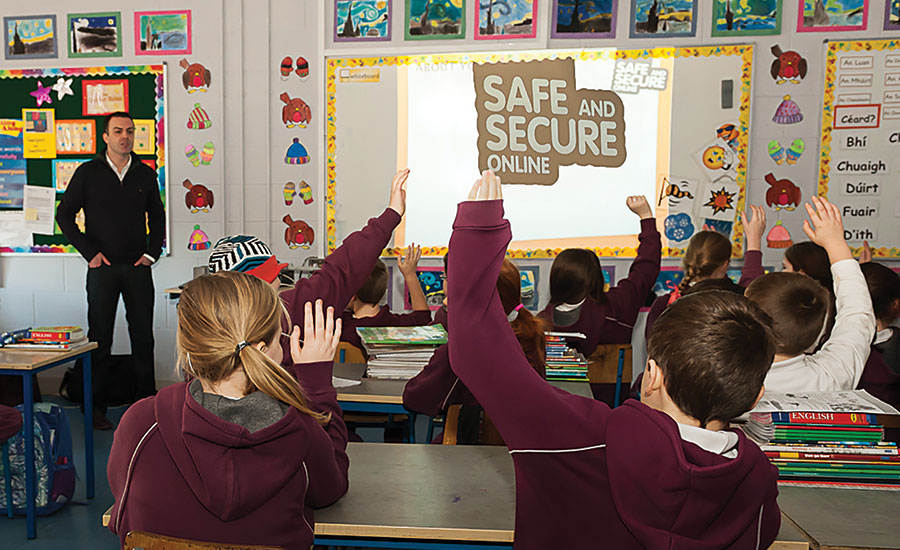Sharing School Security with Law Enforcement


More than 165,000 children across six countries have been educated through the (ISC)2 Foundation’s Safe and Secure Online program since it was founded in 2006. Photo courtesy of the (ISC)2 Foundation


For educational institutions, it may seem like there are never enough resources to cover all of the risks, incidents or areas of a campus. However, by partnering with police and other first responders, school security leaders can gain additional expertise, local risk updates and even force multipliers.
At the Ladue School District outside St. Louis, Missouri, Dr. Jason Buckner fills multiple roles, serving as the district’s safety coordinator as well as Assistant Superintendent for Business and Finance. The district has eight schools with buildings in three municipalities, and finding partners for security among all three areas is challenging.
Annual training requirements for the district involve drills for fire, tornado, earthquake, intruders and bus evacuations, and there is additional training added on different topics such as bullying. Security technology at the schools includes access controls on all perimeter doors, panic buttons so secretaries can alert 911, and more than 200 surveillance cameras across the district.
“We collaborate often with law enforcement officials in our three municipalities,” says Buckner. “They’re involved in our crisis teams and designing our training procedures” so both sides of school security – in-house and law enforcement – are on the same page for response.
Law enforcement officials also have access to the Web link to view the IP camera feeds in the schools, and each patrol car has an access control card assigned to it. This way, Buckner says, police can respond as quickly to any incidents at the schools.
“We cannot be 100-percent safe and secure – it’s just not possible,” says Buckner. “However, by adding technology, training and better processes, we strive to mitigate as much risk as we can.”
The Ladue School District is also implementing new mobile emergency response planning through SafeGuard Risk Solutions. This puts emergency plans such as evacuation routes and procedures onto teachers’ and administrators’ smartphones or tablets, so they do not need to take binders with them. The plans can also be updated electronically, so if there was a personnel change or a new phone number to call, Buckner can push it out through the system easily.
Law enforcement was involved in creating these plans as well, Buckner says, and they will receive access to the plans when the program launches at the beginning of the 2015 school year. Buckner reached out to the three municipalities’ police chiefs and fire chiefs one-on-one to share his ideas and build strategies.
“Creating these plans has heightened security awareness with the staff and has helped us build relationships with our first responders,” Buckner says. “It has essentially forced us to all collaborate to create an effective system for our schools.”
“Working with law enforcement is a force multiplier at no expense to the school,” says Maureen Rush, M.S., CPP, Vice President of Public Safety and Penn PD Superintendent at the University of Pennsylvania in Philadelphia (Penn). Under Rush’s leadership, Penn has been ranked as the top school in the Security 500 Report’s Universities sector for eight years running.
Rush, who has 18 years of experience within the Philadelphia Police Department prior to joining Penn, maintains a close relationship with the city’s police force. The university maintains memoranda of understanding with the Philadelphia PD about patrols zones, investigations, chains of command and command centers. Rush also works with the Delaware Valley Intelligence Center (DVIC), a fusion center that enables force and camera-sharing throughout the Philadelphia area.
Penn is also working closely with the law enforcement at nearby Drexel University and the Philadelphia Housing Authority.
“We share our databases on a daily basis, and through PARS (a court system information sharing program), we avoid blind spots about who has been arrested or who is wanted for what,” says Rush. She also participates in monthly University City Public Safety meetings, which includes law enforcement and other first responders, private building management (such as for nearby high rises), the court system, hospital security and probation or parole officers.
“These meetings enable us to share real intelligence in a timely manner,” Rush says. There is daily reconciliation between Penn, the Philadelphia PD and Drexel PD to cross-check arrests and crime trends, such as alerts to be aware for a particular person who has been seen to steal from students in bookstores or libraries.
“(School security) is all about relationships,” adds Rush. “It doesn’t happen overnight, but staying aware includes staying involved with all levels of your environment.”
SIDEBAR: Educating Parents, Teachers and Students for Cyber Safety
In an ever-evolving online landscape, students are facing more and more risks than ever before, often without even realizing it. Parents and teachers, too, are challenged to keep up with the pace of changing technology in order to keep their children and students informed and safe.
The (ISC)2 Foundation – the non-profit wing of cybersecurity organization (ISC)2 – has launched an initiative to help education students and adults about digital risks and how to stay safe online.
According to David Shearer, Executive Director for (ISC)2, “Now, due to the ubiquitous nature of technology, the risks to children’s safety is changing. It’s essentially an expanded attack surface, and because of the predatory activities on the Web, we’re working to educate teachers, parents and students about the risks out there.”
The program, Safe and Secure Online, has four separate modules:
- 7-10 year-olds: Featuring educational videos about video game awareness and an interactive Q&A session.
- 11-14 year-olds: Includes more in-depth information about risks on social networking, cyber bullying and sexting, as well as sessions on password best practices.
- Parents and Teachers: Before giving instruction to students, the Safe and Secure Online instructor (an (ISC)2 volunteer) goes over the lesson plan with the teacher or parents to discuss any sensitivities and to customize the session.
- Senior Citizens: Launching in 2015, this program includes general best practices for sending sensitive information via email, password security and more.
Part of the challenge, says Dan Waddell, (ISC)2 National Capital Director, is to keep the core curriculum updated. For example, when the Safe and Secure Online program was first created, geotagging (adding location information to social media posts or having an app access your GPS data to aid in search results) was rare, but due to the popularity of smartphones, it’s important to educate students on the potential dangers of publicly stating, through an app or a post, where you are at any given time.
In addition, having cyber-savvy students can lead to more secure homes and schools, says Shearer. “Students who know not to click on bad or suspicious links are less likely to introduce viruses or malware to home or school networks,” he says. “Attackers look for weak links, and educated students are less likely to be duped.”
“Many schools review and revise their own online security programs and training once we leave,” says Waddell. “After a class, we leave behind resources and links to help teachers and administrators supplement security awareness and training – we want them to want to do better, and to change the culture of the school.” Want to get involved? Learn more at www.isc2cares.org/Safe-And-Secure/
Looking for a reprint of this article?
From high-res PDFs to custom plaques, order your copy today!









